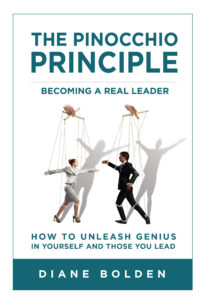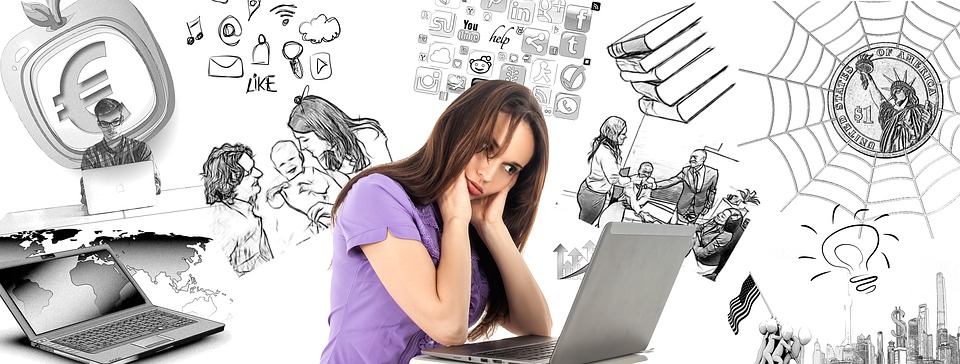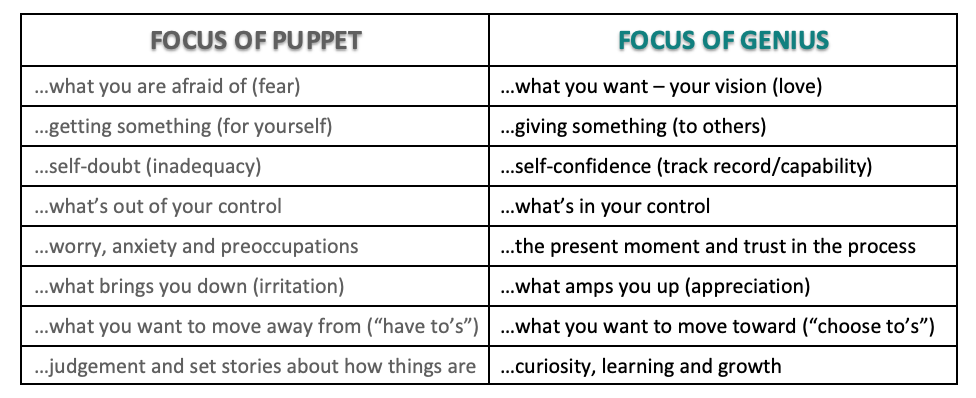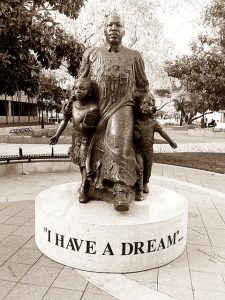Category Archives: Inspiring Yourself & Others
Why What Got You Here May Not Get You There – and What to do Instead
Imagine that software you’ve relied on for years stops working for you. You notice your computer has been freezing up a lot and you’ve been experiencing some glitches. At first, it didn’t really bother you. You just made do and went on. But now it’s happening so often that you’re having trouble getting things done.
When you look into the problem, you find you’re not the only one experiencing it. In fact, after receiving numerous user complaints, the company discovered its software was having incompatibilities. Much to your relief, a new version of the program is being rolled out that has fixed all the bugs. And happily, this updated program is now available for you to download.
The same thing happens to each of us. You’re cruising along doing what you’ve always done only to find it just isn’t working so well anymore. You aren’t getting the results you wanted. Or worse, what worked before is actually causing new problems. And despite your best efforts, these problems are throwing a big monkey wrench in things.
Take Shiela as an example.
Shiela is a high achieving executive who has always prided herself on her ability to be the “go to” person for solutions. Her energy and enthusiasm led her to be sought out for plum projects and invited to serve on numerous committees and boards. She happily took these things on and went the extra mile to deliver excellence in everything she did. And her career trajectory was headed ever upward.
But over time, the number of initiatives she was regularly involved in began to wear on her. Her calendar was packed and she hit the ground running each day only to find that her to do list was growing faster than her ability to get things done. She had multiple balls in the air and lived in constant fear that one of them would come crashing down at any moment.
Her solution was to double down on what helped her succeed in the past. She worked more, slept less, and pushed herself beyond the limits of her own exhaustion. And though she was working harder than ever, her performance began to suffer. The work that once energized and inspired her was beginning to feel like an endless grind she just couldn’t rise above. And people began to notice.
Well-intentioned friends and colleagues gave her books and advice, and she did her best to try to institute new approaches, take better care of herself, delegate, prioritize, rely on systems and get support. But when things got tense, she reverted to old patterns of behavior that were deeply ingrained.
Shiela’s old program was interfering with her new one. And this interference was causing major glitches. But those glitches didn’t have to keep her from achieving her desired results. She just had to find the bug that was creating the havoc and take steps to eliminate it.
So how do you find a bug in your program?
Like Shiela, you start by recognizing that you aren’t getting the results you want. And then you work backward. Finding the bug in your program requires that you detach from your actions in such a way that you can observe and evaluate them.
One way to do this is to replay events in your mind to identify any causal factors. You can designate time at the end of the day to mentally review the day’s events and evaluate what went well and what didn’t. You can journal about it. Or you can talk with someone who is an objective third party, like a friend, family member, mentor or coach.
The bug in your program is almost always a knee jerk reaction.
When Shiela replayed her interactions with others, she realized that what she really wanted (and needed) to do when someone asked her to become involved in yet another project, committee or board was to ensure that it was the best fit and use of her time before responding. But she also recognized that before her mental faculty was engaged, she had already pledged her sole support and involvement. And before she knew it, despite her best intentions, she had unwittingly pushed herself further into overwhelm.
She was reacting instead of responding.
Knee jerk reactions are the product of conditioning.
Conditioning is what happens when a behavior becomes so automatic that you no longer need to think about it. And conditioning is good when it leads you to behave in a way that is constructive — like when you practice a new skill over and over again until you can do it without having to remind yourself of each step.
But conditioning that leads you to spring into action when what you really need to do is give a little more consideration to your response can get you into trouble.
There is a neurobiological component to conditioning. Every time you practice something or respond to a stimulus in a certain way, you are creating neural networks in your brain. Neurons that fire together wire together. And the more they fire, the stronger and more automatic their connections (and your behaviors) get. Conversely, when a neural network is interrupted or not used for a certain period of time, these connections begin to weaken.
Once you have identified the bug, you can begin to eliminate it.
Simply being aware of a knee jerk reaction will begin to loosen its grip on you. When Sheila realized she had a tendency to override her true intention by launching into an old undesirable pattern before she even knew what was happening, she also became increasingly aware of the negative consequences that behavior created.
This is not to say that Sheila could instantaneously eradicate her bug and immediately improve her results. On the contrary, she grew increasingly frustrated because now she was not only engaging in problematic behavior — she was doing it even though she knew better. But this awareness is half the battle.
Initially, she didn’t recognize her oversights until after the fact, but with increased awareness and attention Sheila noticed them sooner and sooner. The time it took her to catch herself went from hours to minutes and with continued diligence, she was able to take steps to correct them in real-time. Ultimately, she got to the point where she could prevent herself from engaging in this automatic reaction altogether.
As the bug is eliminated, the program can be upgraded.
Upgrading the program is a matter of replacing an old behavior with a new one. Unlike software upgrades, this one isn’t a matter of a simple download. It requires attention, thought and persistence.
As mentioned previously, neural networks that correspond to old, undesirable patterns of behavior weaken when they are not engaged. And as they weaken, repeated practice allows new neural nets to be formed that support a more desirable behavior.
But doesn’t creating new neural networks require a huge amount of practice?
The interesting thing about the formation of these neural networks is that they do not have to happen in real-time. Research has shown that mentally rehearsing a new pattern of behavior leads to the same growth in neural networks that physical practice does.
As Sheila began mentally reviewing the way she handled herself in conversations, she reflected on what she would have liked to do differently. And then she replayed the scene in her mind with a new, more desirable ending. She continued to do this daily. As she did, she literally rewired her brain.
Doing so allowed her to create and increasingly rely on new neural networks in situations that necessitated a different response. Gradually she was able to replace her tendency to automatically take more and more on with a more thoughtful, respectful response that offered solutions without adding to her overload. She began to recognize opportunities to involve and empower others to do things that would allow them to grow and buy her much needed time to regroup and reengage in a more focused, less frenetic way.
And over time Sheila once again became known not only for getting results but for making a more strategic impact and growing talent within her organization.
Let’s review the process of upgrading your internal programming
• Step One: Find your bug. The first step is to recognize when you have a tendency to engage in behavior that keeps you from getting the results you desire. Most likely this will be a knee jerk reaction that propels you into action before you have a chance to think.
• Step Two: Disempower your bug. Becoming aware of behavior you fall into and the impact it has on your effectiveness ultimately weakens its hold on you because while it still may be automatic, it is no longer unconscious. Though falling into old patterns when you know better is frustrating, this awareness is a sign of tremendous progress.
• Step Three: Substitute a new program for the old one. As your old habits and the corresponding neural nets that lead you to engage in them begin to weaken, you can replace them with new behaviors. The more you practice these new behaviors (whether physically or mentally), the stronger the new neural networks and your new patterns will become. And the less you engage the old behaviors, the weaker and less prominent the old neural networks (and the corresponding behaviors) get.
If you find yourself engaging in behavior that is interfering with your effectiveness, the most important thing to remember is that you are not the program that is running it. You are the programmer. You have the ability to consciously choose the behaviors and the responses you have to any given stimulus.
Though interrupting and upgrading your internal programming takes time, the results will be well worth your effort. And the best part is that you don’t have to lodge a complaint with or rely on anyone but yourself in order to do it.
If you’d like some support in recognizing and overcoming bugs in your programming, consider joining me in the Spring session of The Pinocchio Principle Unleashed – The Real Leader’s Guide to Accessing the Freedom & Flow of Your Authentic Genius. A few seats remain for this exclusive 13-week leadership development program, which kicks off on March 3. If you have questions or would like to chat about whether the program is a fit for you, you can schedule a call directly with me.
Here’s what a previous participant had to say…
“My professional goals were not going the way that I wanted them to and I had a suspicion that I was pounding my head against the wall trying the same tools or switching the tools differently and I just needed a fresh perspective on them. I enrolled in the Freedom & Flow program after receiving encouragement from people who work with Diane who raved about their interactions with her and how impactful she’s been in their life.
One of the things that this course helped me realize is that I always believed the tools that made me successful early in my life and my career would be the same tools that would see me through to the end. The truth is that my toolbox needed more tools, or different tools in it.
This is important for folks that would be thinking about this program, and it was revolutionary for me – what worked for me early in my career isn’t going to work all the time, I can’t say that enough. You need to reexamine. You can’t have the same script for your whole professional career, you just can’t. You have to adjust the script. I’m in leadership positions versus before, I was a follower. I was trying to get somewhere. Now I’m somewhere and it’s different.
I’ve taken a lot of leadership courses. They’re usually big group settings. This is a smaller more intimate group. The one on one calls are terrific and super helpful. Diane is energetic, vibrant, engaged, open-minded, and thoughtful. Her program has helped me better influence and connect to others, decrease my stress, and get much more done. I’m more mindful and have replaced old, ineffective tools with new ones – it feels great, it’s really refreshing.
My message to folks who are considering this course is pretty simple: you will learn new skills, new tools that you haven’t used before which are going to help move you forward. The program is awesome, and I highly recommend it.”
Dr. Tony Sciscione, Director, Maternal-Fetal Medicine at Christiana Care Health System
Are You Operating from Your Genius or Your Puppet?
Last week I posted a video about the story of Pinocchio and the relevance it has as a metaphor for each of us as leaders. As I mentioned in that video, that story is about much more than a puppet whose nose grew when he lied.
It’s the story of a puppet that longs to become REAL. It’s also the story of anyone who feels like they’re trapped by their circumstances – who knows there’s got to be something more than the way things have been going, who doesn’t quite feel ALIVE and may feel like life is beating them down.
Like Pinocchio, we too have a burning desire to become REAL – to access the greatness (Genius) within, to be a part of something meaningful, to make a greater impact as only we can. We’re born with these impulses.
But until we become REAL LEADERS, we function largely as puppets – bound by our conditioning, trapped by our well-worn habits and patterns, operated by external forces pulling our strings, and confined by the programming we’ve inherited or internalized.
And when we exercise the courage to embrace our own journey toward becoming a Real Leader, we free ourselves from those strings and unleash our GENIUS.
What is Genius, exactly?
People often think of genius as an extreme level of intelligence that only certain people have. But it is more than just intellectual capacity. And we are all born with it.
Genius is the masterpiece in the marble – what stands after everything that is not the masterpiece is carved away. It is the life blood of our organizations, our people, our very selves. It is what unites us and makes us strong. It allows us to overcome our most formidable obstacles and rise to our most daunting challenges and promising opportunities.
GENIUS is the power of the human spirit.
How do you know if you are operating from your Puppet or your Genius?
Here are a few indicators that I teach in my thirteen-week signature program, The Pinocchio Principle Unleashed – The Real Leader’s Guide to Accessing the Freedom & Flow of Your Authentic Genius.
When you are operating from your puppet, you are largely focused on…
- …what you are afraid of (fear)
- …getting something (for yourself)
- …self-doubt (inadequacy)
- …what’s out of your control
- …worry, anxiety and preoccupations
- …what brings you down (irritation)
- …what you want to move away from (“have to’s”)
- …judgement and set stories about how things are
In contrast, when you are operating from your Genius, you’ll see things quite differently:
And when you move from your Puppet to your Genius, you’ll have a very different experience too.
You’ll enjoy:
- the energy and vitality to perform at your highest level without getting beaten down by stress, pressure and overwhelm,
- a renewed passion and sense of meaning that gives you the strength to overcome obstacles and resilience to bounce back from setbacks,
- heightened creativity and ingenuity to find answers to problems that previously stumped you – and to navigate change, challenge and uncertainty with courage, confidence and ease, and
- the ability to create strong connections with people that inspire trust and increase your ability to influence and truly lead.
What can you do to better align with your Genius more of the time?
It all starts with awareness. Most of us do not realize the degree to which we operate as Puppets. Nor do we appreciate the Genius that is waiting in the wings, eager to emerge.
Start by checking in with yourself regularly to determine where your focus is. Notice how you feel when you are operating from Puppet, as well as Genius. Referencing the chart above, ask yourself what you can do to make the necessary shift.
And if you’d like more support on the journey, consider enrolling in The Pinocchio Principle Unleashed – The Real Leader’s Guide to Accessing the Freedom & Flow of Your Authentic Genius. Registration for the spring session, which will kick off in March, is now open. To maximize personal interaction and individualized support, enrollment is limited to 10 people.
You can get more information here. And if you have questions or would like to discuss the program in more detail, you can schedule a call directly with me.
Image by Thomas Skirde from Pixabay.
It’s Time to Live Your Dream
“If one advances confidently in the direction of his dreams, and endeavors to life the life which he imagined, he will meet with a success unexpected in common hours.”
~ Henry David Thoreau
Over the history of time, there have been among us people who dared to dream big and ended up creating something magnificent as a result. What they had in common was not their station in life, their family inheritance or even necessarily a solid education. Many rose up despite odds that would suggest their lives would be quite ordinary, or insignificant, perhaps growing up amidst gangs and violence and poverty to become leaders whose life stories would inspire millions of others from all backgrounds and circumstances.
What differentiates these people from the rest? And what can we all learn from them?
“Nothing happens unless first a dream.” ~ Carl Sandburg
People who do amazing things in the world often have a dream that they lovingly nurture and protect. From somewhere in the depths of their being, they know they are capable of greatness – not because they were born into it or are particularly more gifted than everyone else, but simply because it is their birthright – as it is for all of us.
Each one of us has the ability to create something extraordinary. We all have different talents and strengths, diverse styles and passions – along with a unique combination of experiences (for better or worse) that allows us to discover and apply them to create something bigger than ourselves. We may not know exactly what form it will take, but if we pay attention to the whispers and yearnings of our hearts, we begin to make out the shape of something that beckons to us.
As children, most of us received mixed messages. We may have been encouraged to follow our hearts and give life to our dreams, in addition to being conditioned to be practical, hedge our bets and take the safest route. Over time, many of us have allowed the roar of public opinion – that often tells us our dreams are frivolous, selfish and unlikely to come to fruition – to silence that small still voice within. But those among us who have risen against their odds have learned to reverse that process and believe in themselves and their dreams despite the overwhelming evidence around them that would suggest that success is improbable.
“If you lose hope, somehow you lose the vitality that keeps life moving, you lost that courage to be, that quality that helps you go on in spite of it all. And so today I still have a dream.” ~ Martin Luther King
The beginning of each year brings with it the question of what you will focus your time, energy and resources into accomplishing. It is an optimal time to reacquaint yourself with your dreams and visions, your purpose and values, and the question of how you can become a living example of that which you most admire. You may be quite sure of what it is you would like to create, do, have or become. Or perhaps you have only small pieces of a bigger puzzle that has not yet come together.
The power of your dream will be bolstered by the degree to which your vision expands beyond your own interests to those of others around you. Spend some time contemplating where you feel most drawn and why. When you land on something that will allow your gifts to align with those of others to accomplish complementary goals, you will join forces with something much greater than yourself. It will lift you up when your energy is low and sustain you through moments of doubt and fear.
Perhaps the whispers of our heart and the calls to greatness that we feel within our souls are essential components of a larger, collective plan that we each play a vital part in. As we rise up to play these parts fully and wholeheartedly, we can revel in the beauty of its mysterious unfolding. In the process, we will discover ourselves to be greater than we thought we were and use each moment of our lives to create something extraordinary for ourselves and others.
“Behind every great achievement is a dreamer of great dreams.”
~ Robert K. Greenleaf
The above article contains excerpts from my book, The Pinocchio Principle: Becoming a Real Leader – How to Unleash Genius in Yourself and Those You Lead, available on Amazon.com and BarnesandNoble.com. 
How to Find that Peaceful, Easy Feeling (even amidst stress, overwhelm and uncertainty)
Recently, I had the opportunity to sit with a relative who was having an echo cardiogram – which is essentially an ultrasound of the heart. It was an awe-inspiring experience.
We’re obviously all familiar with the fact that we have hearts. And that they beat. And that without them, we wouldn’t be alive.
But I realized that in many ways, we (or at least I) have become all TOO familiar with that fact. So familiar that it’s easy to forget about it altogether – and completely take it for granted.
There was something about seeing that image of a real human heart – beating steadily and with such incredible precision – that simply took my breath away.
It may sound silly, but I couldn’t help but muse over the fact that the vast majority of us don’t have to be plugged into anything or pack pre-charged batteries into our bodies for our hearts to continue doing what they do. We don’t need to set reminders, or worry about getting it right, or rely on anyone, or do anything at all for that matter.
A few days later I found myself sitting in one of my favorite places, next to a little creek under a canopy of sprawling eucalyptus trees that lines one of the streets in my neighborhood. It’s a place that I can lose myself in entirely, so full of beauty and peace that if I sit there long enough, I can feel the stress dissolve like little beads of water that evaporate in the sun.
A moment later, a car came screeching down the road – very likely exceeding the 25 MPH speed limit by double or more. My peace and ease were shattered for a moment, as I felt the anger bubble up within my body. I watched as my quiet mind was barraged by thoughts of frustration and resentment, conjuring all kinds of unpleasant scenarios at the danger that was created for kids riding their bikes or people walking their dogs.
And then I turned my gaze once again, from the street to the little creek with the light dancing upon the water and the graceful, willowing branches of leaves fluttering in the breeze above it. I took a deep breath, and in that moment I realized three things…
(1) I could choose which sensation I wanted to experience by deciding which thought I would give my attention to. The feelings of peace and contentment were still available to me – I just had to be willing to release the sudden attachment I felt to anger and hostility.
(2) The decision I would make in that moment would impact the trajectory of the rest of my day. Giving in to my irritation would not only keep me from enjoying a peaceful, easy feeling; it would also keep me from sharing it with others and using it to navigate gracefully through whatever challenges and opportunities awaited me.
(3) The beauty and bliss and peace I was previously experiencing, like my heartbeat, is always available to me – to all of us. I am just not always aware of it. And sometimes I unwittingly choose to put my attention on things that completely eclipse my awareness of it altogether. But it doesn’t have to be that way.
Despite the changing times we live in, the little (and big) disturbances we often have to deal with, and the frustrations and challenges that threaten our peace, we all have some things that are constant in our lives – that when appreciated allow us to feel truly blessed, loved and cared for.
As the holidays grow nearer, and we prepare to gather and break bread with people who are special to us, it does us all well to pause and appreciate with wonder and awe the things in our lives that we don’t often stop to think all that much about.
Here’s to the beauty that surrounds us, the love that is always available, and the uncompromising glory of our magnificent beating hearts.
5 Phases of Transformation – and How to Navigate Them
We’re all working through our share of change – change that comes to us from the outside in.
But there’s another kind of change that happens from the inside out.
And that feels a little different. It usually comes on gradually – so gradually you may not even notice it at first.
In the video below, I’ll share the five phases of transformation that I’ve observed in my own life as well as the lives of executives I’ve coached over the years. You’ll learn what you can expect in each phase – and I’ll give you some tips for making the most of it, so you can move through it with ease and grace.
Change – even the kind that comes from the inside out – can be unsettling and anxiety producing. But it is a doorway that leads us to some of the greatest gifts life has to offer.
If you’d like some support and guidance navigating through your own transformation, I encourage you to consider joining me and a small group of fellow leaders in the fall session of The Pinocchio Principle Unleashed – The Real Leader’s Guide to Accessing the Freedom & Flow of Your Authentic Genius kicking off on Wednesday, 9/30.
I’ll be personally guiding an intimate group of executives through this process over the next thirteen weeks utilizing a powerful blend of online training, small group mastermind meetings and one-on-one coaching support. Space is limited and there are a few seats remaining.
If you have questions or want to chat about the program, feel free to set up a call.
How to Find Peace in The Midst of Chaos (and why your future self will thank you)
If you stir muddy water, it will become murky and dark.
But if you allow the water to settle, the debris will eventually sink and you’ll be able to see more clearly.
The same is true of each of us.
There’s a lot to be stirred up about right now. And perhaps that’s why it’s more important than ever for us to find our calm.
Though our current Covid-19 response is leading us to drive less and stay home more, many of us are having difficulty finding places of peace and stillness. You might feel like you’re working more than ever, now that the lines between work and home are completely blurred.
Throw a kid or two into the mix whose routines (and lives) have been completely upended and you have a perfect mix for chaos.
And of course, there is the ever-present temptation to grab your phone or iPad or fire up the television to tune into the latest news or binge watch those shows on Netflix you’ve been wanting to see.
In addition to our external distractions there is the internal commotion of our never-ending thoughts, worries, and preoccupations.
It’s enough to make your head spin.
But perhaps there is hope amidst the chaos…
I recently read that for the first time in thirty years, the Himalayas are visible from northern India. Air quality has improved in several areas of the world, including right here in the United States. These improvements are said to largely be a product of the coronavirus response that has led to fewer emissions.
What if in addition to cleaning up our air we could find a way to clear our heads as well?
What if our future depended on it?
In such an unpredictable time as this, one thing is fairly certain: there is no more “business as usual”. Even after our social distancing and stay at home mandates have been lifted, things are likely to be different moving forward than they’ve ever been in the past.
Out of necessity, much of life as we’ve known it has had to change – often for the better. Many of the ways we have always done things will likely no longer be effective (or even relevant).
We have the opportunity to reinvent ways of working and being that weren’t serving us all that well and chart a new course into our future.
Now more than ever, we must cultivate the insight necessary to know what we need to do next.
And insight is a product of slowing down, quieting our minds and tuning in to ourselves and each other. It requires us to cut through the noise and create space for new ideas to land.
The best way to do that is to practice presence.
What exactly is presence?
The word present derives from the Latin past participle praesse meaning “to be before one”, from the roots pra – pre + esse – to be.
Presence is a state of being that’s achieved when we are truly in the moment, allowing it to unfold without judging it, labeling it, or getting lost in our thoughts about what it means or what we believe should be happening.
Presence allows us to cut through the clamor of our preoccupations, worries and fears so that our true selves can emerge. It is a gateway through which our intuition and inner wisdom enters and expresses itself.
A moment of presence is a state of grace that can produce great insights that help us to truly learn from our experiences, make the most of our opportunities and rise to our challenges in creative ways.
In moments of presence, we know who we really are and what we are truly capable of.
Have you ever noticed that people tend to match each other’s intensity and tone when they are together?
Comments about trivial matters are often matched with similar banter. Expressions of fear or dread often elicit responses that are equally charged, and expressions of anger have a way of provoking reactions that people later regret.
In a similar manner, moments of presence when shared with others can evoke powerful responses that can be revealing and transformational.
This is because when you are truly present with another human being you create a space that allows that person’s true self to come out as well.
This is why the best leaders have learned to become comfortable with silence. They listen more than they talk, and to allow themselves to become instruments that help others to recognize their own greatness – not necessarily through anything that say or do, but rather through moments of presence that are created and shared with others.
So how does one cultivate a moment of presence?
It is really rather simple, though far easier said than done.
1) The first step is to be still.
That’s right. Sit still. I know it goes against everything you were probably taught about getting things done and being useful. But do it anyway.
You can practice now, while you read this. Become aware of your breathing, of the space you are sitting in, of the weight of your body and how it feels in this moment. Feel the life inside you and trace it to each part of your body. Listen to the sounds around you. Take a deep breath. Let it out slowly.
2) Become aware of your thoughts.
Observe the activity of your mind as it continues to process whatever is there – thoughts like, “this is silly, really – I have way too much to do to be sitting here, doing this…” and “I have to remember to call so and so back today,” and “What did my [boss, colleague, friend, etc.] mean when he/she said…”.
Recognize that you are not your thoughts, but rather the thinker of your thoughts. Simply watch them parade around, without getting sucked into them. Feel how much bigger you are than all of that. Continue to breathe it in.
3) There really is no step three.
Simply continue to repeat steps one and two, immersing yourself more deeply into the experience with each breath.
You don’t need to do this for an extended period of time, unless you want to. Often even a couple of minutes are sufficient to bring you to a more intense state of awareness and aliveness.
In these moments of presence, you will experience things on a different level – one that allows you to respond from a deeper, wiser part of yourself. And when you are with others, you will bring out that deeper, wiser part of them as well.
The wonderful thing about practicing presence is that it creates a fertile landing place for creativity and new ideas. The more often you do, the more frequently you may find yourself receiving inklings (often when you least expect them) about solutions to even the most confounding of problems.
Presence is incredibly powerful to practice with others as well, and a wonderful thing to engage in with the family members in your home (who you are likely seeing more of than ever before). The process is the same, except that you expand your awareness to take in the other person as well.
First, put your phone down. Turn off your IPad, computer, television and/or any other device that could potentially steal your attention and focus.
Then, look into the eyes of the person in front of you, and listen to what they are saying. But listen to what they are not saying as well.
Presence is more about being than doing. So, allow yourself to truly BE with another, devoid of judgments, labels, and agendas. When you listen from this place, you are like water to a thirsty plant, allowing others to open up and soak in needed nutrients.
And in this space, they may just find the answers they seek as well – not because you are giving them, but because you have created a space that is illuminating for everyone.
For more on practicing presence, cultivating insight, and reinventing the way you live and lead, check out The Pinocchio Principle Unleashed: The Real Leader’s Guide to Accessing the Freedom & Flow of Your Authentic Genius. Registration for the fall session will open soon (and if you join the waiting list, you’ll have first dibs on the limited seats that will become available).
Image by Gordon Johnson from Pixabay.
How to Contain the Spread of… FEAR (even amidst a pandemic)
To say we are living in a time of great challenge and uncertainty would be a major understatement.
There’s no dispute that we’re currently facing a virus over which we have very little control.
But there is another contagion being propagated that we have every ability to contain.
And that is FEAR.
Fear does funny things to people. At its worst, it produces panic — a physical state that literally disables the brain’s ability to think clearly. There is seemingly no other explanation for the current shortage of toilet paper. It just isn’t rational. But the greater the shortage, the higher the demand.
When people are in fear, they bypass their ability to think and are easily influenced by mass hysteria and knee jerk reactions. They also tend to put their own needs above those of others.
Fear triggers our instinct for self-preservation, leading us to scan our environment for anything that indicates that danger is present.
But when we’re gripped by fear, we just don’t see things clearly. And the more fear there is, the more evidence there seems to be to suggest there is something to fear, which of course elicits more fear.
Fear narrows the aperture of the lens we view things through. In other words, we are only seeing a small fraction of the entire picture. It’s like staring at a dot on the wall by smashing your face against it. The dot is all you’ll see, even though the room you are in is exponentially larger than the small dot right in front of you.
- You’ll put your attention on what is wrong, rather than what is right.
- You’ll spend more time and energy on describing, complaining about, and magnifying the problem than on finding the solution.
- You’ll be more concerned with what you can get rather than what you have to give.
- You’ll focus more on what is out of your control than on things you are able to influence.
- You’ll tend to feel helpless rather than hopeful – and you’ll act in ways that lead others to feel that way too.
But each of us has the power to turn this fear response around. And it is imperative that we do it now.
Though most of us have never lived through a pandemic as extensive as COVID-19, we have all likely weathered a few storms over the course of our lives.
And we’ve not only lived to tell about it, but also learned a thing or two along the way. In times like these it is essential to draw upon that wiser, calmer part of ourselves that knows this too will pass – and that we can rise to these challenges with courage and grace.
I call this vital part of ourselves Genius. Here are three simple ways to activate it:
1. Do whatever you can to quiet your mind and calm yourself down.
When fear hijacks your system, your thinking will be cloudy, and your body will be on high alert. The cortisol that gets released will increase your heart rate and blood pressure. Your neural activity will be diverted from the most highly developed part of your brain to the most primal.
As a result, you’ll experience a fight, flight or freeze response. You’ll be prone to seeing dangerous things that aren’t there – and inclined to screen out helpful things that are.
To counter that reaction, take some deep breaths. Get oxygen flowing back into your cells. Then, ask yourself a question that moves your neural activity back into your prefrontal cortex, the part that allows you to think deeply and make good decisions.
A question like, “What do I really want?” or “What could I do to make this situation better?” will help you get back on the right track.
The more you can quiet your mind, the more space you’ll create for inspiration and answers to come in – and the more likely you will be to recognize and act on them when they do. Rather than unconsciously reacting, you can respond with thoughtful intention.
2. Choose curiosity over judgment.
Once you’ve come to a fixed conclusion about something, you are not likely to consider other perspectives. Cognitive science tells us that confirmation bias leads us to take in information that aligns with our current beliefs and screen anything that contradicts them out.
And from that mindset, you’ll run the risk of behaving in ways that make things worse.
But while judgment narrows your aperture and keeps you in a fixed position, curiosity opens it and allows you to get unstuck. Your lens zooms OUT rather than IN.
Instead of only seeing that small black dot, you’ll take in more of your surroundings. In place of the wall that once blocked your progress, you’ll see possibilities and solutions that can move you forward.
Notice anything you may currently be believing that could be shutting you down or causing more stress – and challenge it. Ask yourself, “Is it really true?”. Rather than paying attention to what your eyes are showing you, get curious and ask, “What am I NOT seeing?”
3. Shift your focus from what you stand to lose to what you have to gain.
In the face of this international calamity, we have all had to make sacrifices. Life as we know it has drastically changed.
Offices, schools, stores, restaurants and other establishments are closed (or have limited access). Travel has been halted. The market is taking a hit. Your daily routine has likely been obliterated. The safety of people you love (and you, yourself) is in question. And as a result, social distancing has become an imperative.
But amidst all this, there are things to be optimistic about.
-
- For many of us, the crazy hustle bustle that compelled us to run from one thing to another is giving way to opportunities to slow down, rest and find our bearings.
- Our true priorities are coming into focus, allowing us to find more meaning and purpose in the things that we do and the way that we do them.
- Though we cannot always be in each other’s physical presence, we can stay connected. We can (and must) lean on our advancing technology to communicate with, support and care for one another without being in the same room.
- We are facing a collective challenge that has the power to bring us together despite our differences. As we worry less about ourselves and find ways to help each other, we activate reserves of strength and resilience we may not have realized we had.
- When nothing is certain, anything is possible. We can view the current disruptions we must deal with as opportunities to find better ways of doing things we never had reason to evaluate. We can be more intentional and conscious in everything we do.
In summary,
1. Do whatever you can to quiet your mind and calm yourself down.
2. Choose curiosity over judgment.
3. Shift your focus from what you stand to lose to what you have to gain.
As you take these steps to become more connected with your own Genius, you’ll hold a space for others to do the same. Your ability to remain calm and optimistic will rub off. And you’ll not only quell the virus of fear but also proactively extend the hope and optimism that will allow us to prevail both individually and collectively.
Now THAT’s something worth spreading.
For more on connecting with your Genius, check out The Pinocchio Principle: Becoming a Real Leader – How to Unleash Genius in Yourself and Others.
Did you enjoy this article? Share with someone who could benefit from reading it: https://dianebolden.com/2020/03/19/how-to-contain-the-spread-of-fear-even-amidst-a-pandemic/
*Image: Pixabay 2020
Are You a REAL Leader? What Pinocchio Can Teach You About Becoming One
I’m thrilled to announce the re-release of my book, The Pinocchio Principle: Becoming a Real Leader with a brand new cover! In addition to a new image, the revised cover sports a new subtitle: “How to Unleash Genius in Yourself and Those You Lead”.
Often when I tell people that I wrote a leadership book called The Pinocchio Principle, they assume it must have something to do with ethics. It’s understandable, since the first thing most of us think of when we hear “Pinocchio” is a puppet whose nose grew when he lied. Pinocchio could easily be used as a metaphor for people who lie through their teeth while their proverbial noses grow…
And… it’s also easy to see why some might think it is a commentary on the importance of honesty in leadership.
While being truthful to oneself and others is a vital part of being a “real” leader, the reason I chose Pinocchio as a metaphor goes much deeper than his nose.
You see, the underlying narrative is, Pinocchio is a puppet who longs to become REAL.
Like Pinocchio, at our core we too have a burning desire to become real, (authentic, resourceful, truer to ourselves, in better service to others, etc.) to bring into creation the greatness that resides somewhere within us.
After all, you were born with these impulses — to give form to your distinctive blends of talent, energy, passion and style.
We all come into the world equipped with far more than we are immediately able to utilize or even comprehend. And though these rich parts of ourselves are always there, they have a way of becoming latent over time.
Throughout your career, you’ve no doubt come across people who have a special way of tapping into that well of available greatness.
They seem to effortlessly draw forth bits of the magic, access energy reserves, continually improve skills and pursue their passions. These are the people we love to watch and be around — they do what they do so well that it is an art.
As they tap their inner reserves and unleash their own greatness, they inspire each of us to do the same… and that’s what sets them apart and elevates them to the level of “Real Leadership”.
In Walt Disney’s rendition of Pinocchio, the puppet encounters a blue fairy. She tells him, “When you prove yourself to be brave, truthful, and unselfish, Pinocchio, then you will become a real boy.” You can imagine what Pinocchio might have been thinking upon hearing these words. What are these things this fairy speaks of? How do I get them? What must I do? How long will it take? Where do I start?
With the promise of a dream fulfilled, he endeavors to do whatever is necessary. And the odyssey begins. The twists and turns it takes are trials we can all relate to, and challenges that are a part of our human experience.
The qualities that the blue fairy encourages Pinocchio to demonstrate are not things he must acquire. They are attributes he already possesses. But to activate them, he must endure a series of events that allow him to realize these qualities are there and to exercise them accordingly.
In order to return to himself—his true self—Pinocchio must endure a journey of trials and tribulations that first lure him away from himself. And the same kind of drama seems to unfold in one way or another for each of us.
You have — within you — an animating Genius.
This Genius yearns to take different forms depending on the circumstances. Real Leaders could be defined as those whose Genius longs to create something for the greatest good, which is ultimately accomplished for, with and through others.
It has a keen ability to look around, see possibilities and utilize resources in a way that brings something into existence that benefits others, whether that is a family, a community, a non-profit organization, a corporation, or the world at large.
To accomplish this, leaders have the distinct charge of working with others in a way that brings out their best — that allows those we can impact to find the Genius within them and apply it in service of accomplishing a common goal.
However, before you can bring out Genius in others, you must start with yourself.
Many times the primary meaning of “to lead” is associated with directing something on a given course, or being in charge, and this can be one of the functions of leadership. But the essence of leadership is much more than that. The Merriam Webster Dictionary has the following entry as the first definition listed for the word “lead”: “a: to guide on a way especially by going in advance.”
If one of the essential functions of a leader is to bring out the best in others, this definition would suggest doing so requires that leaders first bring out the best in themselves. This, in and of itself, is the very same odyssey our friend Pinocchio finds himself on: To discover and liberate within himself what is real — divinely inspired Genius — and to courageously apply it in a way that is truthful and unselfish.
I wrote The Pinocchio Principle: Becoming a Real Leader to serve as a roadmap for bringing out the best in yourself and others. My desire is to help you bring to fruition your greatest dreams and visions and better navigate through the perils and possibilities along the way. The book was written to help you:
- Better differentiate what is true within yourself from the conditioning that would have you acting in ways that are inauthentic and self-defeating.
- Gain clarity on your unique call to leadership and leverage your experiences to prepare for something bigger.
- Explore navigational tools that will help you determine the extent to which you are on or off course and the direction you need to take next on your journey to becoming a Real Leader.
- Recognize and prevent assumptions and beliefs (your strings) that keep you from your best work so that you can utilize ego in service to something greater.
- Recognize and steer clear of the elusive promises (Pleasure Island) that divert you from your truest fulfillment.
- Face your greatest fears (the belly of the whale) in a transformational way that will reunite you with your own determination, courage and heroism.
- Rediscover the power that lies within (the fairy’s wand) to create and live your dreams.
- Find ways to return to the quiet places within yourself that nurture and inform your greatest visions.
The ultimate odyssey is always that of self-discovery. Every challenge, every opportunity gives you a chance to learn more about who you really are and to utilize your inherent gifts in service to something greater than yourself.
As I teach in The Pinocchio Principle Unleashed: The Real Leader’s Guide to Accessing the Freedom & Flow of Your Authentic Genius program, it’s only when you give yourself completely to the journey and find meaning in each step along the way, that you will truly live.
It’s your example and the unique contributions you make in the world that defines you as a Real Leader.
Now, more than ever, Real Leaders are differentiating themselves from people who simply hold fancy titles or have multitudes of people reporting to them. They exist at all levels of an organization, and they have the ability to transform it in ways that will allow it to achieve unprecedented levels of success.
How to Meet Change, Challenge and Uncertainty with Courage and Grace

One of the most common challenges I help my executive clients work through (and often face myself) is navigating through change, challenge and uncertainty.
It’s true what they say – change really is the only thing that is a constant for most of us.
And it has a way of evoking our worst fears, anxieties and insecurities.
The very nature of change thrusts us into circumstances that lead us to feel out of control, beyond our comfort zones, and potentially at risk in one way or another. And when your future is uncertain and all the things that used to work are no longer effective (or relevant), your self-protective mechanisms get triggered.
Left unchecked, your instinct for self-preservation can lead you to engage in behavior that is not particularly productive or constructive. It would have you reacting out of fear, putting your own needs above those of others, mired in doubt and negativity and fixated on obstacles and limitations. From that mindset, you’ll (often unconsciously) act in ways that exacerbate the problems you are already facing.
But, as I teach in The Pinocchio Principle Unleashed: The Real Leader’s Guide to Accessing the Freedom & Flow of Your Authentic Genius program, there is a wiser, stronger part of you that you can access during times that test you – one that will allow you to rise above the fray and meet change and uncertainty head on with courage and grace.
This wiser part of yourself (which I call your Genius) meets fear with resilience and puts service and self-realization over self-interest. It replaces doubt and negativity with optimism and possibility. And it sees beyond limitations to recognize possibilities. It utilizes challenge as opportunity to become stronger, to rise up and discover that you have within you all that you need to prevail.
This part of you is the essence of Real Leadership – which brings out the very best in everyone and everything and channels it into something that serves a greater good. Real leadership is what is required in times of great change, challenge and uncertainty. And it is something that can be exercised by anyone, at any level of an organization at any time.
What most people don’t realize is that the true cause of stress, frustration (and the knee jerk reactions it often triggers) is not their circumstances themselves, but rather the thoughts they are believing (and the stories they are telling themselves) about their situations. Cognitive science tells us that confirmation bias leads us to take in information that aligns with our current beliefs and screen anything that contradicts them out.
So let’s say you believe the problems you face are insurmountable, the people who surround you cannot be trusted, and that you (or others) lack the resources, skill or resolve to overcome your current challenges. Confirmation bias would lead you to take in information that confirms those beliefs and overlook (or disregard) information that contradicts them – even though that information is the very thing that could potentially turn everything around.
And from that mindset, you’ll behave in ways that make things worse. You could very well act in a manner that makes your worst stories (which are likely based on conjecture) become true.
The biggest problem is that you likely won’t even realize you are falling into this trap. You’ll attribute the cause of your frustration, anxiety and stress to your situation rather than your mindset.
As long as you see the problem as “out there”, you’ll feel more like a victim than a victor.
But even in the most daunting of circumstances, you can find something within yourself that has the potential to change the way you are seeing things. And when you change the way you are seeing things, you’ll notice opportunities, resources, strengths and possibilities that would have otherwise been completely off your radar.
The key to liberating yourself from a self-defeating phenomenon is to recognize frustration, anxiety and stress as a key indicator that your thoughts are not aligned with your Genius, so that you don’t take them quite so seriously.
Rather than getting set on what you think you know, ask yourself what you don’t know. What are you not seeing? What are you believing about what is happening? And how much of that are you certain is actually true?
If you are willing to see things differently, your whole world could change in an instant.
The thing about change is that nothing is certain. And when nothing is certain, anything is possible.
If it is possible that we tend to act in ways that make our stories true – and bring about more of what we are focusing on, then the most powerful thing we can do is allow our stories and our focus to shift to something more empowering.
- Rather than putting your attention on what you don’t want, you can create a compelling vision for yourself and others of what you do. Resolve to move toward what you desire rather than away from what you fear.
- When you notice you are fixated on obstacles, see if you can look beyond them to discern opportunities.
- When feeling threatened about all there is to lose, consider what there is to gain.
- Instead of thinking of what you need to get, ask yourself what you have to give.
- Rather than getting lost in your head, reliving the past or worrying about a future that has you living the worst case scenario, challenge yourself to be intensely present to what is unfolding in the moment and the best way to respond to and leverage it.
- When plagued by doubt, think back to previous challenges you successfully overcame and recognize your strengths can get you through this one too.
- When you begin to worry about all the things that are beyond your control, ask yourself what you have the ability to influence and start to make positive change there. Do what you can where you are with what you have.
These practices of Real Leaders will come more naturally when you keep yourself from falling into the trap of identifying with your doubts and limiting beliefs.
It is essential to recognize that you do not need to banish your doubts and limiting beliefs. Doing so is an exercise in futility, since as a human being you will continue to be barraged by these thoughts whether you want them or not.
All you need to do is recognize that there is more to the picture than your current mindset is allowing you see. Don’t let those random thoughts blind you to the solutions that are right in front of you or obstruct your vision of what is possible.
The simple recognition that your thoughts are not serving you in the current moment is enough to allow your mindset to get unstuck. Without a whole lot of effort on your part it will begin to expand, allowing you to get a broader, better view – and connecting you naturally to the mindset of a real leader.
The Real Leader Revolution is already underway, liberating the power of the human spirit in the workplace again even the most insurmountable odds. We are all so much stronger than we think we are, and each one of us is capable of so much more than we realize.
In the face of inevitable change, we can rise up as adventurers and warriors and summon strength that often lies dormant within us until given an opportunity to emerge.
If you are interested in learning more about the qualities of Real Leadership and how to unleash it in yourself and others in your organization, I encourage you to download your copy of The Real Leader Revolution Manifesto, my most recent white paper on how to stop doing business as usual and start liberating the power of the human spirit to achieve unprecedented and sustainable success.
The Super Simple Secret to Outwitting Overwhelm
Not all that long ago, I went through a period where I felt overwhelmed and stuck. Beneath my frustration was curiosity about where it was coming from and what was the best way to move beyond it.
One day, as I was watching my young son do his homework, I had a fascinating and frustrating insight.
This kid is really smart. And his homework is just not that hard for him. He could finish it in the time it takes to make a peanut butter sandwich. But seconds after he would pull it from his backpack a whole new dynamic came into play. It was as though a huge brick wall suddenly erupted from the page and grew a hundred feet tall.
He’d sit and stare at his paper. He’d complain about all the work he had to do. He’d worry that he wouldn’t be able to do it right (or at all). And then he’d become completely fixated on any little thing that captured his attention. A bug. A drop of water on the counter. The way the numbers on the digital clock change with each minute. And hours could go by before he had even touched his pencil to paper.
After watching for a while, I heard myself telling him, “In the time it takes you to moan and complain about it, you could have it done! You can get through this easily – you are so smart!” But nothing I said was getting through.
And then I realized that my son was a mirror image of me when I get overwhelmed.
It’s not that what must get done is all that difficult.
It’s that my mind had a way of magnifying things several times their normal size so that it felt like I must tackle Mount Everest when in reality I only needed to take a little walk around the block. I told myself stories (sometimes consciously and other times unconsciously) about how hard things will be or how long they would take – especially things that were new to me.
And then I’d fall into my old, familiar pitfall of trying to make everything perfect. Before I even realized what was going on, I felt totally exhausted and depleted. And then I needed relief—even just doing something that’s easy—so I could check a box and feel like I had accomplished something, anything.
Once I realized where my son got it, I decided to stop trying to teach him and let him teach me.
In addition to showing me what was standing in my way, he reminded me that all the words in the world don’t make a difference when you are trying to teach someone to do something you have not yet mastered. Kids learn through action, not words. And so do adults.
I knew that to help my son (or anyone else for that matter) in even the smallest way, I had to get busy working on myself. And then a new question arose: how can I overcome a lifetime of perfectionistic patterns that keep me from doing what’s necessary to achieve my grandest visions and goals?
With that question at the top of my mind, I went for a run. As with just about any of my runs, the first few minutes were tough. I was tired and stiff. It wasn’t fun. But I just kept going. And then I fell into my zone. My legs felt lighter. My breathing evened out. My head started to clear. I was actually enjoying myself. I ran a little faster and a little harder. It felt good.
And then I had a second, equally powerful insight.
To break out of the perfectionism trap—to get out of overwhelm, to free myself from my own self-imposed prison—I simply needed to get into action. Even one tiny step toward my desired goal would help – though at first it may be uncomfortable, messy, and far from perfect. And then I could take another, and another and another, until l finally I reach my zone.
Over the last several months, I have found that the more diligence and effort I put into those first few steps, the more quickly I get through that “warm up” period and into a place where I can make some real headway – and even have some fun in the process.
So that’s my simple plan for getting and staying unstuck. And when I need a little more motivation and inspiration, I just go hang out with my son for awhile.
“Life is like riding a bicycle. To keep your balance, you must keep moving.” ~Albert Einstein
Overwhelm is just one of the many states that keep us from taking action toward our goals and visions and doing our best work. If you are interested in learning more about how to find your optimal zone of performance so that your work becomes less cumbersome and more enjoyable, check out The Pinocchio Principle Unleashed: The Real Leader’s Guide to Accessing the Freedom & Flow of Your Authentic Genius, kicking off the week of September 23rd.
This 13-week leadership development program will help you find and stay in your optimal zone of performance so that your work becomes less cumbersome and more enjoyable. It’s designed to help high achieving professionals get better results and make a bigger impact while enjoying their lives more – both on and off the job.
Registration will close soon. Save your seat today!









